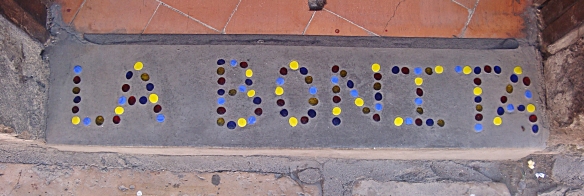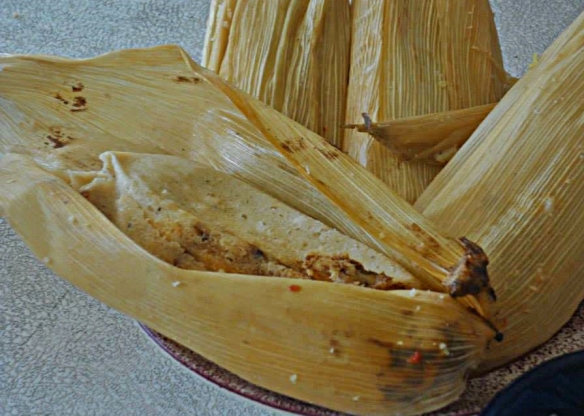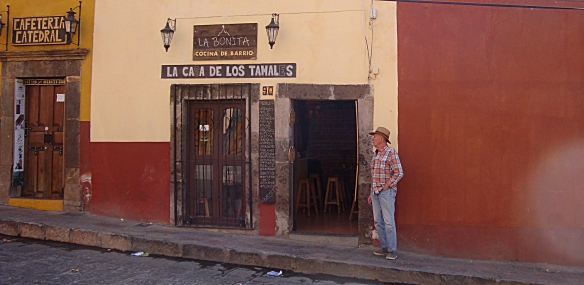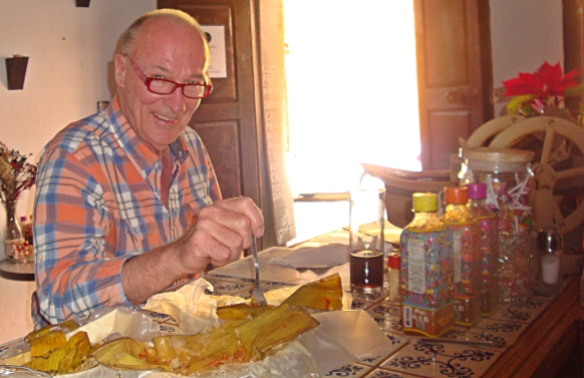It’s a coin toss. As to whether tacos or tamales are Mexico’s favorite comfort food. Except at this time of year when Candelaria is approaching. At this time of year, tamales are the clear favorites.
I’ve always been confused about exactly what Candelaria is. I know it falls forty days after Christmas. I know it’s on February 2. I know it’s also Groundhog Day (which I think when Bill Murray dies he’ll be taking with him). I know it has something to do with the Jews considering a woman unclean for forty days after giving birth. I know all the kids called Candel that I went to high school with were Jews. I know it’s the midway point between the winter solstice and the spring equinox. I know it was Farrah Fawcett’s birthday (but no, I won’t tell you why I know). I know in Veracruz they hold bullfights and parades. I know San Miguel’s Parque Juarez is filled with plants for sale. I know a lot of Mexicans dress dolls up as baby Jesus and take them to church. And I know, on Dia de Candelaria, almost every Mexican (and me) eats tamales.
There are a lot of places that sell tamales in San Miguel de Allende. There’s Katy on Salida a Celaya that never seems to be open. There’s Dona Margarita on Stirling Dickinson. But only early in the morning. There’s the one at the Pemex station on Boulevard de Conspiracion. But only very early in the morning. There’s the guy in front of Don Pedro. But only late at night. There’s Tamales Oaxacana next to Tannat on Ancha de San Antonio. Which I’m never quite sure when it’s open. And then there’s La Bonita on Canal. Which seems to be always open. And for that and some other much better reasons is the reigning king…or perhaps it’s queen…of tamales in San Miguel.
I asked Guillermo Vidal, the owner of La Bonita, the place also called La Casa De Los Tamales, how important Candelaria is to his business. He told me, “La Candelaria is a strong time for us however there are also other times during the year when we are busy.”
In “Que Vivan Los Tamales!”, Jeffrey Pilcher documents a lot of those special times: “The villagers of Tepotzlan, Mexico, consumed these native treats on Christmas Eve after ‘putting the child to bed’, ceremoniously placing a figure of the infant Jesus in a manger of hay. On June 24, the Day of San Juan, residents of Charinda, Michoacan, eat tamales tonto or silly tamales (yes, Jay Silverheels fans, that’s what Tonto means) made of uncooked corn with only a little added pork fat. The people of Huejotzingo, Puebla, offered plain white tamales with mole to deceased relatives on All Saints’ Day.”
But wait, Don Day, this is starting to sound like a boring history or geography lesson instead of a blog that’s about food. Shouldn’t we get back to the something good to eat part of the story, perhaps start with exactly what tamales are?
OK, tamales are basically little packets of corn dough wrapped in either corn husks or banana leaves. They can be either savory or sweet. The flavors are almost endless. But most often they include meat, usually pork or chicken, and a red or green sauce.
One of the reasons I enjoy writing about tamales is it’s one of the very few times…OK, maybe the only time…I get to use the word nixtamalization (a word so weird that Bill Gates underlines it when I type…sorry keystroke…it). Nixtamalization is the processing of the corn that ends up inside a tamale so that it’s easier to grind and, though I’ve never quite believed it, it apparently adds nutrients to the corn. I’ve also never quite understood how, but the Aztecs used to nixtalize with wood ashes and today it’s done with lime.
Lime? Isn’t that what’s used in the construction industry? For almost my entire life, calcium hydroxide or lime or cal as the locals call it was the reason I avoided tamales. Then, about five years ago, I decided to write about them. I went to San Miguel’s tamale makers and asked them if I could watch and take photos of them making their masa, as the corn meal is commonly called.
“Make? You mean buy don’t you? You mean you want to come to Mega with me?”
No, most tamale makers don’t nixtalize. They buy the masa. Either fresh or dried.
But not La Bonita.
“The masa we make it. The masa is fresh each day,” Guillermo Vidal told me. Also mentioning that we use “100% natural corn”.
Tamales are the most documented of all pre-Hispanic foods. In “America’s First Cuisines”, Sophie Coe tells of how the first explorers to arrive in Mexico were served tamales by the Aztecs.
Favorite fillings for the Aztecs included flamingo, frog, salamander, gopher, and turkey eggs. The Mayans included iguanas amongst their favorites. Despite having 27 different, San Miguel’s La Bonita offers none of those pre-Hispanic flavors.
“The tamales most ordered”, Guillermo Vidal told me, “are green salsa, marinated pork leg, mushrooms, Chiapecos, Oaxaca, nutella, pineapple walnut, vanilla, guava, Yucatan, and our specialty for foreigners living in San Miguel, the Mediterranean. The Mediterranean has gourmet products such as goat cheese, eggplant, black olives, peppers, zucchini and tomato sauce with a touch of chipotle.”
To help you through that list, I went to La Bonita, aka The House of Tamales, last week with my friend of 50+ years Peter and, despite being foreigners, we shied away from the Mediterranean, and, with a little help from the camera-shy server, Vero, we tasted some more traditional flavors. I’ll tell you what our favorites were.
In third place was the Veracruzanos. It combines tomato sauce, chipotle pepper, pork ribs and hoja santa, that Mexican herb that some say tastes like anise but I say can best be described as resembling root beer.
Every time I have a tamal (yes, tamal is correct, not tamale) and have my first taste of the masa, I wonder why corn meal isn’t more popular. About the only other time I see it is in Italian polenta. If it could ever escape from outside the banana leaves or corn husks, masa would make a great alternative to risotto.
In second place amongst our favorites was La Bonita‘s Poblanos tamal. It combines Gouda cheese, tomato sauce and guajillo peppers.
“This reminds me of lasagna”, said Peter, “and anything that reminds me of lasagna is going to be something I like a lot.”
And in first place? A tamal with some fairly unusual fillings. A tamal that combines chicken, mole, olives, almonds, prunes and sweet red peppers. A tamal that’s called the Chiapanecos.
The decision was unanimous between Peter and I.
“A bit weird at first”, I said.
“But it sure grows on you”, said Peter.
I’ve never been much on sweet tamales. They’re a little too much like the tapioca pudding that used to be in the weekly dessert rotation when I was growing up (“I think I’ll skip the pudding so I can get to the library before it closes, Mom.”).
But we did try one of La Bonita‘s tamales dulces, the interesting sounding blackberry and cheese. Like I said, a little too much like tapioca pudding.
It was the only tamal that we ordered that came in a corn husk. And I’ve always wondered how a tamal maker decides whether it’s banana leaf or corn husk. So I asked Guillermo Vidal.
“Leaf corn or banana for tamales depends on the origin of the tamal, where it comes from in our country. It is estimated that there are 5000 throughout Mexico. But basically it is by the tradition from which it was first made”, said Guillermo.
“Another difference is that, with banana leaf, tamales retain more moisture in comparison with leaf maize. Leaf maize is drier on the palate.”
One of the reasons that tamales are la comida de la gente, the favorite for Candelaria and so many other occasions in Mexico is, obviously, the cost. At La Bonita, a tamal is $19 pesos. One is enough for a lot of people. Two are enough for me. There aren’t too many cheaper breakfasts, lunches or dinners…and tamales do work no matter what time of day…in San Miguel de Allende.
La Bonita has only been around for ten months. This will be their first Candelaria. Guillermo Vidal doesn’t know how many tamales he’ll sell.
“The sales are important but what matters is creating gourmet tamales that are available to any wallet and with ingredients that are very good in quality.”
“We love to make gourmet tamales. Maybe we will sell 3500 or 500 or only two tamales in the next week…maybe not…but if you like only one, it’s great for us.”
And if you’ve ever wondered, like me, why the restaurant is called La Bonita, that was one more question I asked Guillermo Vidal.
I’d call the restaurant funky but I wouldn’t call it pretty. I’d call the tamales tasty but they’re not pretty either. So who or what is La Bonita?
The answer is Guillermo’s wife.
That even makes a crusty old guy like me go, “Aaaaaaahhhhhhhh!”. And especially after a tamal Chiapanecos.
La Bonita is located at Canal #90 in San Miguel de Allende, Mexico. The restaurant is open every day from 8:30 am to 9:30 pm. You can order your tamales for Candelaria (or any other time) at http://www.tamalhouse.com.












Excellent ‘foodie’ article – thank you. For the first time in decades, I’ll now be buying tamale(i)s in a Walmart parking lot in Sacramento (CA) this weekend!
Oh please, Donday….correct about lye in nixtamal. It is absolutely lime, like that used in construction, and known as cal…not lye. Originally it was tequesquite, from the lake of Texcoco, under Mexico city, which some people still use. Gracias.
I love the tamales that are sold in the morning out in front of La Eglisia de Nuestra Senora de Salud. They are 8 pesos. As I only eat the Rajas con queso as I don’t eat meat, but they are great. And the sister and brother who run the little stand are wonderfully cheerful.